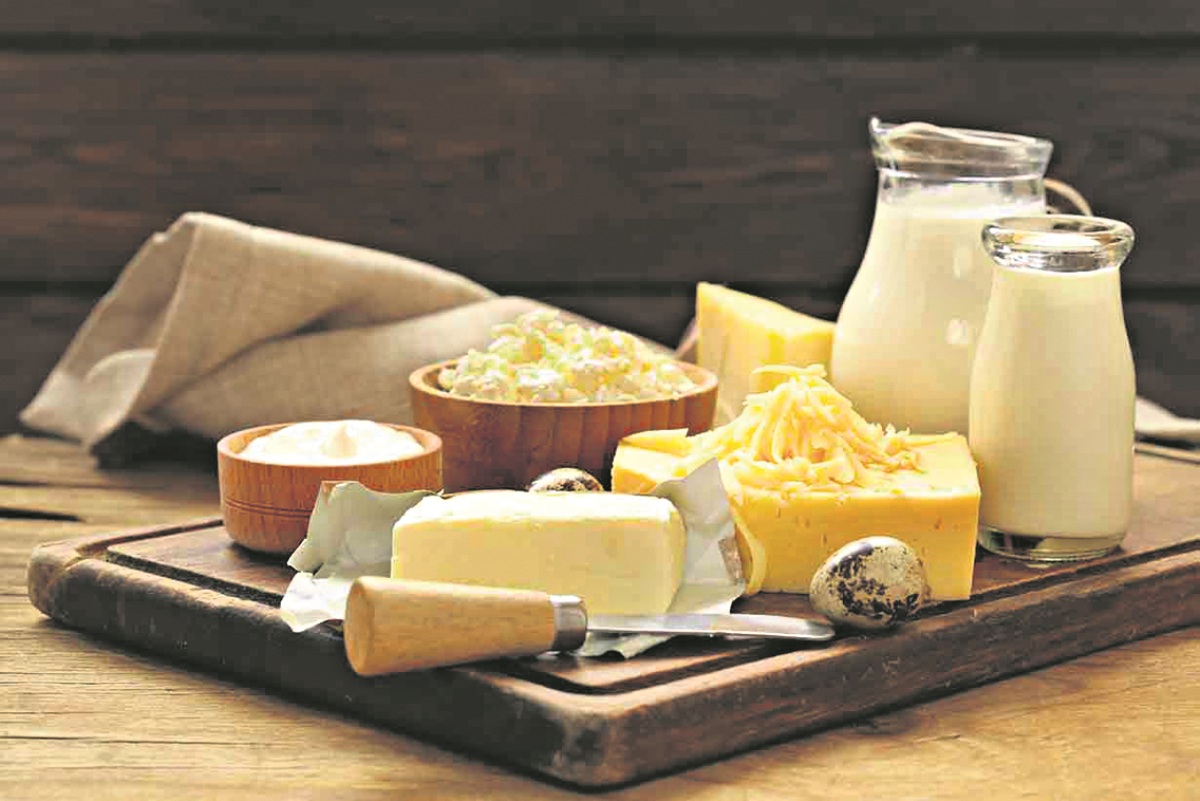MILK AND MILK PRODUCTS TOPIC DETAILED

TSPSC FSO
What is milk ? – Milk is a whitish liquid containing proteins, fats, lactose various vitamins and minerals that is produced by the mammary glands of all mature female to nourish their young for a period beginning immediately after birth.
1. Milk and any of the foods made from milk, including butter, cheese, ice cream, yogurt etc. are the products of milk.
2. The term milk is also used for white colour , non-animal
beverages resembling milk in colour & texture such as soy milk, rice milk, almond milk, & coconut milk.
Water: 87-88 %
Carbohydrate: Approx. 5 %
3. mainly Lactose, which converts to Lactic acid by bacterial fermentation
4. In condensed milk, there is also lactulose which is a little sweeter. Fat: 3-4 % in whole milk
5. contains fat soluble vitamins, pigment carotene & Xanthophylls.
6. contains cholesterol & phospho lipids but is primarily Triglycerides (95%).
7. The fat in milk occurs in the form of droplets or globules, surrounded by a membrane and emulsified in the milk serum part (the whey part or the watery part).
8. Milk is an oil/water emulsion which is not naturally physically stable that is why creaming occurs if it is left to stand . Protein: 3-4 % 1. Casein (80% of milk protein)
9. The casein is arranged in super-structures called micelles, which consist of protein together with phosphate, citrate and calcium.
10. The caseins are actually a group of similar proteins, which can be separated from the other milk proteins by acidification to a pH of 4.6
11.The casein micelles also may be coagulated by addition of the enzyme rennin.
12. Whey protein (20% of milk protein)
13. lactalbumin, lactoglobulin & immunoglobulin.
14. Whey proteins are more hydra ted than casein and are denatured and precipitated by heat rather than by acid . 3. Other protein components
15. include enzymes such as lipase, protease, & alkaline phospha tase, which hydrolysis triglyceri des, proteins, & phosphateesters, respectively. The milk prote ins are of high BV & are readily used by the body Vitamins and Minerals
16. Vitamins A, B6, B12, C, D, K, E, thiamine, niacin, biotin, riboflav in, folates, and pantothenic acid.
17. Vitamin A is naturally in the fat component of whole milk and more may be added prior to sale.
18. whole milk is generally (98%) fortified with vitamin D because it is naturally present only in small amounts. Ca & P approx. 1% of milk, Ca is present as calcium caseinate, calcium
phosphate & calcium citrate. , Other minerals present are chloride, magnesium, potassium, sodium, and sulfur
Acidity: fresh milk pH is 6.5-6.7 at 25°C.
Physical properties of Milk
Viscosity: depends on the amount of fat, size of fat globules & extent of clustering of globules. – Homogenisation & ageing increa ses the viscosity of milk.
Freezing point: -0.55°C, addition of 1% of water to milk decreases the FP by – 0.0055°C.
Boiling point: 100.2
Nutritive Value of Milk : Good quality protein & BV is over 90%. Lysine is abundance.
– Easily digestible fat containing 2.1% linoleic acid, 0.5% linole nic acid & 0.14% Arachidonic acid. Only substance that contain lactose which is essential for: – Synthesis of myelin sheath (galactose) – Favors the growth of lacto bacillus in intestine & decrease the pH thus favouring Calcium absorption.
-Also increases the permeability of Small Intestine for Ca+2 . Poor source of iron & vit. C. Not a good source of niacin but excellent source of tryptophan. Major source of Calcium & riboflavin
-Contamination of milk and milk products
– Milk is sterile at secretion in the udder but is contaminated by bacteria even before it leaves the udder Further infection of the milk by microorganisms can take place during milking, handling, storage, and other preprocessing activities. Few types of micro organisms which found in milk are
1. Streptococcus lactis
2. Achromobacter
3. Bacillus subtilis
4. Coliform bacteria
Different Milk Products
1. Fermented milk products
2. Non-Fermented milk products
Non-Fermented milk products
-Whey protein concentrate: ultra filteration technology is used to concentrate protein in whey to various levels between 20-80%. High BV & PER.
-Skim milk: fat content reduced to 0.5-2 % by centrifugation. Extensive use in bakery & confectionery. Also used for low calorie diets & children who need high protein.
-Evaporated milk: 50-60% water evaporated, clarified raw milk is concentrated in vaccum pan at 74-77°C. fortified with Vit-D, sterilised in cans at 118°C for 15 minutes & cooled. As per PFA condensed milk should contain 26% milk solids of which 8% is fat.
-Sweetened condensed milk: not sterile, made from pasteurized milk concentrated 7 sweetened with 65% sucrose. Contains 9% fat out of 31% milk solids.
-Toned milk: 7% fat; mix of reconstituted from skim milk powder with buffalo milk. ▫ Fat content >5% & SNF 8.5%
-Double toned milk: admixture of cow’s or buffalo’s milk or both with fresh skimmed milk or by admixture with skim milk reconstituted from skim milk powder. ▫ Should be pasteurised & show negative phosphatase test. ▫ Fat content 9%.
-Recombined milk: It is the liquid milk obtained by adding skim milk powder (SMP) to water and adding milk fat separately to achieve the desired fat and total solids content.
– Filled milk: homogensied product prepared from refined vegetable oil & MSNF& water. ▫ Fat content > 3% & SNF 8.5%
– Malted Milk is a powdered gruel made from a mixture of malted barley, wheat flour, and whole milk, which is evaporated until it forms a powder.
– Malt powder comes in two forms: ▫ Diastatic malt contains enzymes that break down starch into sugar; this is the form bakers add to bread dough to help the dough rise and create a good crust. ▫ Nondiastatic malt has no active enzymes and is used primarily for flavor, mostly in beverages. It sometimes contains sugar, coloring agents, and other additives.
– A lactose-free milk is available for people who are lactose-intolerant. This modified milk is made by filtering regular milk to remove half the lactose. The enzyme lactase is then added to the milk to break down the remaining lactose into simpler forms which the body can absorb.
-flavoured milk is a dairy drink made with milk, flavourings and sugar, often enriched with vitamins and calcium.
– Ultra-high temperature (UHT) processed milk: packed & asep tically sealed in pre-sterilized containers under aseptic con ditions. ▫ can be stored Unre frigerated for atleast 3 months. ▫ Cooked flavour due to denaturation of β-lactoglobulin.
-Standardised milk: fat is main tained 4.5% and SNF 8.5%. Mix of buffalo & skim milk.
– Dry milk: made with whole milk or skimmed milk dehydrated to about 97% by spray drying & vaccum drying. Good shelf life. Highly hygroscopic & can be reconstituted to fluid milk.
– Khoa: semi-solid obtained from milk by evaporating in open pans with continuous stirring in circular motion. Yield is about 20% of weight of milk used.
– Rabri: concentrated sweetened product comprising several layers of clotted cream. Sugar is added to milk reduced to 1/3 of its original volume.
– Chhaina: major heat & acid coagulated product. Used in sweets like rasmalai, rasogolla, etc. Ice-cream: frozen dairy product consisting of whole milk, skim milk, cream, butter, condensed milk products or dried milk products. Milk fat (MF) & milk solid non-fat (MSNF) constitute 60% of total solid giving it a rich flavour, improved body & texture. ▫ Also contains sugar, stabiliser, emul sifier, flavoring material, water & air. ▫ Sugar provides
sweetness, smoothness & lowers the freezing point. Stabiliserpre vent formation of ice crystals. Forms gel with water & thereby improve body & texture. e.g., gelatin, sea weed, china grass & CMC. ▫ Emulsifier help disperse fat globules throughout the mix & prevent clump formation, further help make ice-cream dry & stiff.
– Cream is the high-fat component separated from whole milk as a result of the creaming process. It has a higher proportion of fat droplets to milk than regular fluid milk; and according to federal standards of identity, cream must contain 18% milk fat or more. Due to this high fat content of cream compared to milk, some yellow, fat soluble pigments may be apparent.
– Various liquid creams available for use in foods include the following: ▫ Light (coffee) cream: 18–30% butterfat. ▫ Light whipping cream: 30–36% butt erfat. ▫ Heavy cream: 36% butterfat, minimum. ▫ “Half-and-half” cream diluted with non-fat milk: 10.5% butterfat. ▫ Whipping cream packaged under pressure in aerosol cans; may be non-fat or contain various levels of fat, sugar, flavouring, emulsifiers, and a stabilizer.
Fermented milk products
– Butter ▫ fat content is generally about 80%. ▫ Made from sweet or sour cream. ▫ Butter is a concentrated form of fluid milk produced through churning of pasteurized cream. Churning involves agitation that breaks fat globule membranes so the emulsion breaks, fat coalesces, and water (buttermilk) escapes. ▫ The original 20/80 oil-in-water type of emulsion of milk becomes a 20/80 water-in-oil emulsion. ▫ Milk is churned to form butter and the watery butter milk. Butter may have a yellow color due to the fat-soluble ani mal pigment, carotene, or an additive. ▫ Butter spoil as a result of hydrolysis of TG molecules releasing free butyric & caproic acids.
Sabbidi Ramesh
Lecturer in Botany & Neet faculty,
Govt Junior College,
Banswada-
8179227595.
Latest Updates
దేశంలో ‘జీవన వీలునామా’ నమోదు చేసిన మొదటి హైకోర్టు?
తాత్వికతను తెలిపేది.. రాజ్యాంగానికి గుండెలాంటిది
ఎలకానిక్ రికార్డులు.. ప్రాథమిక సాక్ష్యాలు
శుక్రకణాలు తాత్కాలికంగా నిల్వ ఉండే ప్రాంతం?
సెకండరీ ఎడ్యుకేషన్ కమిషన్కు మరోపేరు?
‘వెయ్యి ఉరిల మర్రి’ గా పేరుగాంచిన ఊడలమర్రి ఏ జిల్లాలో ఉంది?
రక్షణ దుర్గాలు – నాటి పాలనా విభాగాలు
క్యారెట్ మొక్క ఎన్ని సంవత్సరాలు జీవిస్తుంది?
ప్రపంచ ప్రసిద్ధి అగాధాలు – ఐక్యరాజ్యసమితి లక్ష్యాలు
అణు రియాక్టర్లలో న్యూట్రాన్ల వేగాన్ని తగ్గించేందుకు ఉపయోగించే రసాయనం?






